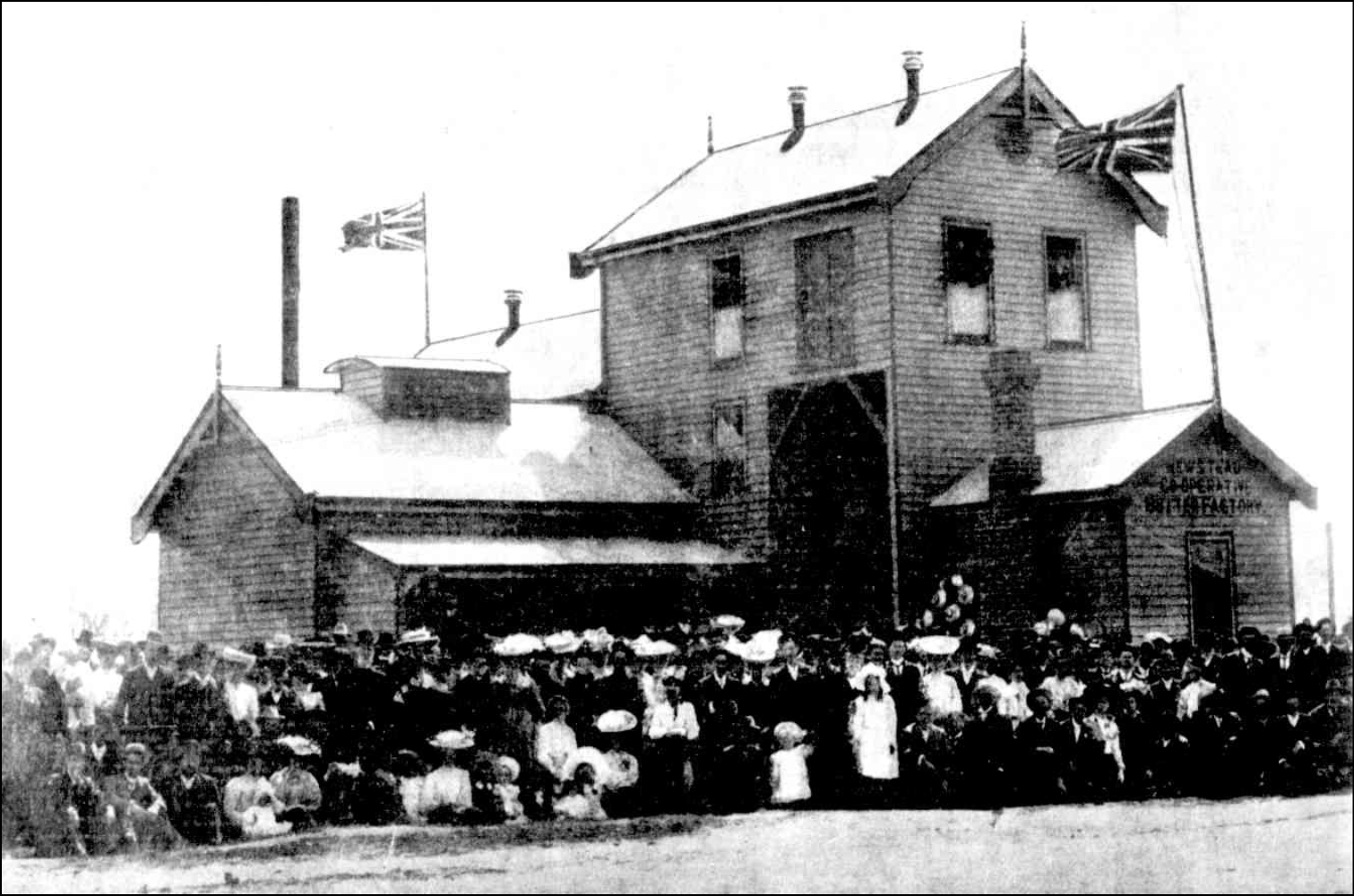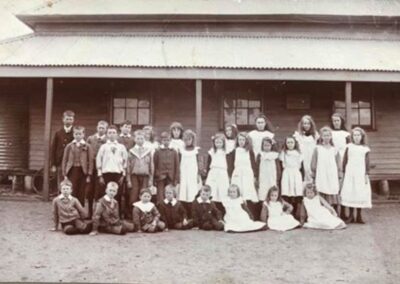
Joyces Creek ‘Atlantis’ hidden in the watery depths
The foundations of the Joyces Creek settlement and railway station were submerged under the rising waters of the newly created Cairn Curran Reservoir in the early 1950’s. Like Atlantis they disappeared into the watery depths. Joyce’s Creek resident and CMRT committee member, Steve Harrison, uncovers the story.
As you pedal, stride, or ride your way out of Newstead to Maryborough, you’ll notice the tall brick chimney to your right. The chimney marks the former site of the Newstead Co-operative Butter Factory. The factory started operations on 17 July 1905 and proved a very successful enterprise (pictured above). As gold mining waned, the factory brought renewed prosperity to Newstead.
Initially, cream was sourced from local dairy farmers, but as production grew, supply came from as far away as Donald and Birchip in the Mallee. The factory developed a reputation for fine quality butter which was sold into local markets and even exported to London. But tastes and markets change. By the late 1940s farmers were leaving dairying and into beef production. The butter factory eventually ceased operations in 1975. The factory has since been converted to a private residence and events venue (see gallery image below).
After crossing the Pyrenees Highway, the wide, fertile alluvial plain of the Loddon River opens up before you. It is this area, much of which is now flooded by the Cairn Curran reservoir, that was at the centre of the thriving dairying industry that developed in the late nineteenth century and led to the formation of the co-operative and construction of the butter factory in Newstead. These days the land that isn’t flooded is largely devoted to crop and sheep farming.
The trail soon swings to the left, leaving the original railway alignment which continued on the lower ground towards Joyces Creek. The trail now follows the new railway alignment. The re-alignment was necessitated by the construction of the Cairn Curran dam and reservoir. Work on the dam commenced in 1946 and it was officially opened by Victoria’s irrepressible premier, Henry Bolte, in 1956.

Joyces Creek Old Railway Bridge - Pam Connell
When the water level in Cairn Curran ebbs low enough, the original railway alignment can still be traced. It is possible to walk on the platforms of the Joyces Creek Railway Station. Imagine yourself alighting here on a day in October 1884, having made the short journey from Newstead on the 11am train. You are part of a large crowd making its way to a picnic day being held at the Joyces Creek State School. This first-hand account of the day’s activities was published in the Mount Alexander Mail dated Saturday 4 October 1884:
A picnic of the (Joyces Creek State School) was held yesterday under very favourable weather, although in the early part of the morning the sky looked very threatening.
This outing was looked forward to as one of the leading events of the year in this district, and the gathering was even larger by a good number than on former occasions. At an early hour people were seen making their way from Newstead towards Joyces Creek, some walking, others driving, while about fifty went by the train at 11 a.m., returning at 7 p.m.
At noon dinners were laid out neatly on the grass, and eatables were in great abundance, that supplied nine different spreads under the care of Mesdames Annand, Brebner, Butler, Mitchell, Currie, McKay, Ryan, Frankling, and Horton. After the repast was partaken of amusement of various kinds that suited old and young were heartily joined in, amidst much merriment. The large paddock of Mrs McKay’s was well chosen for being suitable for the pleasure-makers.
There were races for the girls and boys, some of which were keenly contested. Messrs Nomens, Mitchell, and Butler were the principal movers in getting up this fun for the young. Games of cricket and what is termed rounders, were indulged in by the grown-up of both sexes, at which the ladies enjoyed themselves immensely.
A visit from the brass band of Castlemaine, under the leadership of Mr John Treacy, played several choice and lively tunes, particularly so to those who took the opportunity of dancing on the green. At 5 o’clock the visitors were provided with another ample spread, while Messrs Nomens and Colquhoun became favourites by bringing bags of lollies that they scattered about to the approval of the young.
A novelty at the picnic was two reapers and binders, under the name of Deering and McCormick, which were watched with interest at work. Messrs Turvey and Mitchell lately purchased these, and a trial was given to them by placing a quantity of hay on the sheaf board, which was taken by the elevators and turned out a well-tied sheaf. A deal of household work required with the original reaper will, with the new machine, be done away with.
The different kinds of sport were kept up with great vigour till nearing the time for arrival of the 10 minutes to 7 train, when the ground was gradually cleared of the large assemblage. Altogether, there were fully 500 persons on the ground, who appeared to be thoroughly satisfied with the day’s outing. The band played from the grounds to the Mechanics’ Institute, where a concert was held, which ended the most successful gatherings ever held in the district.
Today, little trace remains of the Joyces Creek State School in its original location. The site is submerged when the water level in Cairn Curran is at its highest. But when levels are low it is possible to find some remnants of bluestone cobble pathways that were laid around the building.
As you make your way along the viaduct over Joyces Creek heading towards Carisbrook and Maryborough, look down to the far bank on your right. The school house (see gallery image below) – taken some six years after the picnic day – stood just below the reservoir high water mark at a distance of about 150m from the viaduct.



